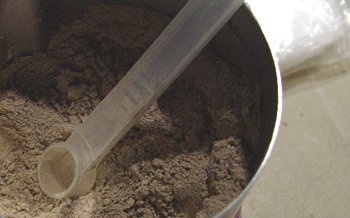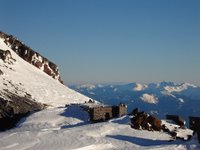This post will eventually describe the climbing I did on Labor Day weekend with my old pal Parker.
But first I want to talk about what I did this summer.
You will recall that I spent a disappointing, rainy week in New Paltz at the end of June/beginning of July.
In the time since then I have been silent.
It has been a wonderful couple of months. I've had exciting travels and adventures.
Unfortunately these exciting travels and adventures did not include rock climbing.
Hence my silence. But I think you, my rock climbing audience, deserve a little taste of what my summer has been about.
I went to New Hampshire twice, and even reached the top of Cannon Cliff. I was in the area on daddy duty, shuttling my two kids to and from summer camp. Climbing was not on the agenda. So although we went to the top of Cannon, we did not scale the cliff via a classic route like Moby Grape (5.8). Instead we took the Aerial Tramway.

(Photo: View down Cannon Mountain from the Tramway on a somewhat foggy day.)
While we were in Franconia Notch State Park we also took in the sights of the Flume Gorge. This natural rock channel is nice, though not nearly as nice as the rock climbing that is available just up the road. The hike through the gorge is fun, I guess. I recommend it if you are in Franconia Notch and by some cruel turn of fate you are not allowed to go rock climbing.

(Photo: The Flume Gorge in Franconia Notch State Park, NH.)
After I dropped the kids at camp, my wife Robin and I found ourselves for the first time in many years with two weekends completely free of the children, during which we could do whatever we wanted. This was my big opportunity. I could have gone climbing. But it didn't feel right. It seemed more appropriate for us to do things Robin and I would both want to do, as a couple.

(Photo: Montauk Point.)
So we went to the beach on the first weekend, and went hiking in the Adirondacks on the second.

(Photo: Avalanche Pass.)
On our first day in the Adirondacks we did a long day hike from Adirondack Loj past Marcy Dam and on to Avalanche Pass. The hike then continued up from Avalanche Pass to reach the summits of Mt. Iroquois and Mt. Algonquin (the second-highest mountain in New York) before returning to the Adirondack Loj via the trail past Wright Peak. Our route covered more than fourteen miles of wilderness. Much of it was quite rugged and wet. The trail from Avalanche Pass up to the saddle between Iroquois and Algonquin was especially steep and slippery. For much of its length, this segment of the trail required rock-hopping up a running stream. We enjoyed the challenge, and the views got better and better as we progressed, with numerous waterfalls along the way and Mt. Marcy gradually appearing behind the summit of Mt. Colden.

(Photo: Mt. Marcy just starting to peek out from behind Mt. Colden.)
While we were hiking Robin and I passed by quite a few rock climbs. In Avalanche Pass there is a lot of climbing, notably a 5.9 on Mt. Colden called California Flake. When we went through the pass this climb was soaking wet-- it has been a rainy year-- but still I wished I could hop on it. As we continued through the pass we got a great view of the Trap Dike, a long scramble up a huge gully on Mt. Colden. This is also a popular ice route in the winter. The Trap Dike is much bigger than I'd previously realized. It is truly impressive. Even though it is an easy climb, barely fifth-class, I'd love to come back to do it.
From the summit of Mt. Iroquois we had a good partial view of Wallface, the largest cliff in New York. For years I've been itching to do the classic Wallface route Diagonal (5.8), but I've never found the time to do it. It can't be tackled from NYC in a single day. At a bare minimum you'd have to set aside a weekend to get up to the region, hike in, and do the climb. Staring at Wallface from above, seeing the cliff in real life for the first time, I was awestruck. It appeared not just huge, but ominous and spooky. I got chills just looking at it.

(Photo: Wallface Mountain, seen from the summit of Mt. Iroquois.)
On our second day in the Adirondacks, Robin and I did an easier hike up the trail past the peaks known as the Three Brothers to the summit of Big Slide Mountain. (This was about eight miles round trip.) Along the way we got a glimpse of the rock climbing routes on the summit cone of Big Slide Mountain. There are just a few routes (and keep in mind I have not tried them!) but this location features incredible views of the entire Great Range. I would consider returning here for the climbing, as limited as it is, because the setting is especially scenic. As Robin and I discovered, this is a great hike even if you don't partake of the rock climbing at the end. The trail was quite muddy during our visit, which was not a problem except that Robin wasn't wearing her hiking boots. After the long hike the day before, her ankles were sore and it was too painful for her to wear her boots on our second day. So she negotiated the mud in her Converse sneakers. It worked out fine, but I wouldn't recommend Converse All-Stars for hiking, or for much of anything, really. Robin's pair went straight into the trash as soon as we finished the hike.

(Photo: View of the Great Range from the part of Big Slide where the rock climbing begins.)
When our children returned to our custody in mid-August we took off on our biggest adventure of the summer: we flew to London and then sailed off on a ten-day cruise to the fjords of Norway.
This was a family trip with Robin's parents, sisters and nephews. A cruise was not our preference; it was imposed on us. We've never been attracted to the cruise lifestyle and we both expected to feel stifled by the whole environment. I didn't like the idea of being constrained to follow the cruise's schedule, and any cruise, by its very nature, makes it impractical for me to incorporate my two sports-- climbing and cycling-- into the vacation. So we went into the whole cruise thing with low expectations.

(Photo: Kayaking with my daughter at the head of the beautiful Geirangerfjorden, Norway.)
Despite ourselves, we loved the cruise. The ship was pretty swanky, the scenery incredible. Norway is the most beautiful place I've ever been. We sailed by gorgeous fjords, kayaked beneath huge waterfalls, hiked past mirror-like lakes to beautiful blue glaciers, and danced our hearts out every night in the ship's disco.

(Photo: Cruising the Innvikfjord
en, Norway.)

(Photo: Aurlandsfjorden at sunrise.)
After the cruise was over we spent a few nights in London. We had wonderful weather and had fun seeing the Tower of London, the Tate Modern, and Buckingham Palace, among other sites.

(Photo: The Tower Bridge in London.)
All of these travels were wonderful, but I'm sad to say that even while I was off seeing the world and having a great time, my obsessed mind never strayed too far from all the climbing I was missing.
I couldn't wait to get back at it. We were due to return home just before Labor Day weekend. I prayed the weather would cooperate. I had a partner lined up: my old buddy Parker, the man who'd braved the rain to belay me when I finally got up the sac to lead MF(5.9). I hadn't climbed with him in nearly two years, but he sent me a message while I was abroad saying he was coming up to the Gunks from Virginia for Labor Day weekend. He asked if I could meet him on Saturday.
Could I?? Hell yes!
The forecast was iffy. It was supposed to be muggy and in the 80's. There was a 40 percent chance of thundershowers.
Ultimately we got pretty lucky. It didn't rain until after 5:00. And the crummy forecast kept the hordes at bay. We had our pick of climbs, even though it was a holiday weekend.
Without meaning to, I ended up revisiting several of the first 5.9's I ever climbed at the Gunks, back in .
I drove up to meet Parker in New Paltz with no big ambitions to fulfill. I hadn't been climbing outside in nearly two months and hadn't seen a climbing gym in weeks. After my cruise vacation I felt fat and out of shape. I had no idea how I'd do once we actually got down to climbing.
Still I didn't want to defeat myself by not even trying, so when we met at the parking lot I volunteered for the first lead and suggested a climb: Bonnie's Roof. I thought it would be a good choice because it is a pretty casual 5.9 with a very well-protected crux. I was pretty sure it would be no problem for me and that it would build confidence. And I thought that if by some miracle I was really feeling good I could run the first pitch right into the Bonnie's Direct finish (also rated 5.9), doing both pitches in one.
Also Bonnie's is one of my favorites and I hadn't been on it this year. Why not give it a go?
Well, it went fine, but it didn't feel all that casual. It was so humid out that I was quickly bathed in sweat. I chalked my hands repeatedly but they still felt slippery. I started placing pro very frequently-- Bonnie's Roof allows placements at will-- and soon I gave up the thought of running both pitches together.
Even though I scaled back my plans I wasn't too worried about the pitch, since the crux protects so well. I remembered my first time on the route, four years ago. It was one of the best days ever: I successfully led CCK (5.7+) onsight and then Bonnie's. Both of them were big deals to me at the time. On that day, while I was still on the ground getting set to start climbing Bonnie's, I remember that a passing stranger suggested to me that I bring the blue #3 Camalot for the crux. On that occasion I had committed, getting fully into the steep bit at the roof before realizing it was time for the blue cam. When I suddenly remembered the stranger's advice, I slammed the piece in and clipped it, then desperately pulled up on the great handholds while my right foot flailed about, trying to get established on the right side of the corner above the roof. Finally I was able to get the foot on the wall and stand up. What a great feeling that was... and of course it was all so unnecessary!
This time, in , I placed the blue cam from below. You can reach right up and slot it behind the point at the end of the roof, before you step up into the steepness. There is no need to desperately plug and go. And with a little footwork the moves are not an issue. It is still a great feeling to get over the roof, and then the rest of the pitch is very casual.
I built a belay at the end of pitch one, wishing I had brought a knife to cut all the junky slings off of the fixed station there. I don't know why this station exists. It is too high up for top-roping and no one raps from it. The slings are all old and faded and it is hard to tell what the newer bits are attached to. I have never used this station without backing it up. If I go up there any time soon I plan to chop it.
Parker made quick work of the Bonnie's Roof Direct finish. I wasn't sure how it would feel to me on this greasy day but I remembered it feeling surprisingly easy last year. This time I think I puzzled over the first move for longer than I did when I led it last year. Chalk it up to my being out of practice. When I finally made the move, slotting my hand in the vertical crack and moving my feet up until I could reach the jugs, it went well and the pitch was over within seconds. I wished I'd led it.
Once we got back to the ground, we saw the cliff was starting to get a little crowded. People were lining up for Ursula (5.5) and there was another party headed up Bonnie's. But I was shocked to see no one on Ants' Line (5.9). If this climb was available I had to do it. Ants' Line is one of those climbs that gets toproped to death, because it has a bolted anchor at the end of the pitch and there is a 5.7 way to reach the bolts (via Sleepwalk). Thus it is seldom open. I hadn't managed to get on it in three years.
Ants' Line was my very first 5.9 lead. It is a first 5.9 for many people because it follows a vertical crack up a corner which eats gear. There is no mysterious crux move but it builds in steepness as it progresses. It requires endurance and good corner technique.
I think I did a pretty good job on this one in . I placed a ton of gear and got tired, but I hung on to the finish. It was another one of those magical days in which it seemed like a whole world was opening up. I led my first 5.8's (Arrow and Airy Aria) earlier in the same day, and when those climbs went really well, I decided to go for it on Ants' Line. The corner looked so inviting. After Ants' Line went down, I felt like I'd become a totally different climber in a single day. Maybe I ascribed too much significance to this one 5.9 lead-- maybe this overconfidence led in some way to my broken ankle on Insuhlation (5.9) later that same year.
In I hoped it would be just another 5.9, well within my limits. I hoped to prove to myself I wasn't as rusty and out of shape as I felt.
I think I probably did a better job on Ants' Line in than I did this time. My hands were so greasy in the humid conditions, I started rushing because I just wanted it over with. Aware that I was getting tired, I didn't execute the moves with much finesse. Still I hung on and completed the pitch. It remains a great climb, and one I will hop on again-- if I ever see it open.
It was Parker's turn and he decided to lead Teeny Face (5.10a) in one pitch. This is one I'd like to lead some time myself. The crux is pretty short, just a couple of crimpy sequences that lead to jugs. I top roped it once with Maryana and really enjoyed it. Following Parker, I liked it very much again. He looked solid negotiating the steep moves up the orange face. The lead looked reasonably well protected to me, although you do make the crux moves above the (bomber) gear. On my turn, the moves seemed harder than I remembered. I got through it, but on one of the crimps I could easily have blown it.
I was starting to feel pretty worn out. Was it the heat? I had planned to lead Obstacle Delusion (5.9) next but after we finished Teeny Face I decided I didn't have to prove anything to anyone and that we might as well dial it back a bit.
I suggested we do Modern Times (5.8+). But when we walked over to it another climber was just starting up.

(Photo: You're in the wrong place, my friend! A climber snookered by the tree into going off-route on Modern Times (5.8+).)
Standing there at the base of Modern Times, Parker and I noticed that, miracle of miracles, the entire High Exposure buttress was empty. Parker mentioned that he'd never done Directissima (5.9). This seemed like a great option for us. I told him I would lead the short 5.8 first pitch, and then he could lead the second, crux pitch and run it together with the glorious 5.6 pitch to the GT Ledge.
This was yet another 5.9 climb that I first attempted in . In retrospect, I don't think I was really ready to lead it at that time. Back then I couldn't figure out the crux move. I ended up falling on the fixed pin at the crux, then hanging, and finally pulling on the draw attached to the pin to reach the next hold. I have since gone back and led it clean. The climb remains one of my favorites. The first two pitches are both odd and little frightening, with tenuous traverses. Then the payoff comes with the beautiful 5.6 climbing up the point of the arete, with great views on either side of you due to your position on a buttress sticking out from the face of the long cliff.
Pitch one of Directissima is a little bit intimidating right off the ground. But I'd led it twice before so with Parker I had little hesitation as I stepped right up into the layback position on the smeary, angled ramp. Once you step up the climbing is easy, with good pro, until you reach the crux move, traversing past the point of the buttress, reaching around a bulge to a big jug. It is a balancy maneuver with poor footholds. There is good pro to your left but the ground feels awfully close. Once you brace yourself and make the reach over, you scamper up and right to a belay ledge next to an obvious, chalked-up finger rail that heads left.

(Photo: Parker at the crux of Directissima (5.9).)
Parker was taking the crux pitch so now I could just sit back and watch. The traditional second pitch of Directissima is only 25 feet long. It traverses straight left for fifteen feet on the narrow finger rail across a steep face, and then a reachy crux move past the pin takes you to a little ledge. The first challenge is getting yourself to commit to the finger rail. It is kind of scary. But once you're in it the finger locks are very good and you can (and should!) get a couple of placements (yellow Alien/Metolius) along the way.
Parker hesitated at first, right at the start of the pitch, but once he moved out onto the face he made it look easy. He is over six feet tall so the crux reach required no special technique from him. He breezed right out to the pin and then moved up to the ledge in no time. Then at my urging he continued, doing the nice 5.6 pitch to the GT Ledge as well. When I followed it went well. I found the traverse to be more comfortable than I remembered and I dispatched the crux move with surprising ease-- I don't want to wreck it for you so I won't say exactly how. But it isn't actually all that reachy if you do it right. I've actually solved it in two different ways.
Once I joined Parker at the GT Ledge it seemed almost churlish not to finish with the crux pitch of High Exposure (5.6+). The climb was just sitting there open, with no one on it and no one waiting. How often does that happen? It had been a few years since I was last on the climb-- if I'm not mistaken I think my last time was when I followed Liz up the pitch in -- and while there may have been a time when I never wanted to do it again, the climb made for a great last pitch of my day with Parker. It was just interesting enough for my rusty bones and brain. With no worries and the humidity finally seeming to lift a little, I started to fully relax and just enjoy myself for the first time all day.

(Photo: The classic top-out shot on High Exposure (5.6+).)
As we descended to the ground, debating whether we should do another climb or call it quits, we could hear the sound of thunder in the distance, heralding not just an incoming storm but with it a change of weather. It was time to declare summer over and go home.
It was sort of a lost summer for me, climbing-wise, with no climbing achievements to savor. Whether I can get in shape for any big accomplishments in the fall remains an open question. So far has been a year in which I've grown increasingly comfortable trying to climb 5.10's in the Gunks, but I still have precious few sends to my credit on such climbs. I do have climbing time mapped out for the autumn, including a couple of days in the 'Dacks in late September, and with some hard work and a little luck I hope I can translate these days into something that feels like progress.




















 So far, the comments have been very positive; in particular, many expressed appreciation of the increased lighting.
So far, the comments have been very positive; in particular, many expressed appreciation of the increased lighting.

































